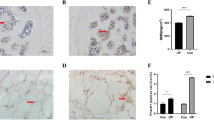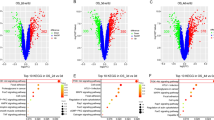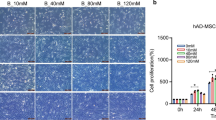Abstract
The dysfunction of bone marrow mesenchymal stem cells (BMSCs) in balancing osteogenesis and adipogenesis plays an important role in the occurrence and development of osteoporosis. It’s still unknown that whether ATP-binding cassette g1 (Abcg1), a well-proved regulation gene of adipogenesis, regulates osteogenesis. In our previous study, we identified 30 differentially expressed genes in osteogenesis and found the expression level ofAbcg1 negatively related to osteogenesis among these genes. Abcg1 is a well-proven adipogenesis regulator and cholesterol transporter, but it’s role in osteogenesis remained unknown. In this study we found it may control osteogenesis, further elucidating the exact role of Abcg1 in regulating osteoblast differentiation would help propose new strategies to prevent and treat osteoporosis. Therefore, we established Abcg1 up- or down-expressed C3H10T1/2 and C2C12 cell lines and verified that Abcg1 knockdown enhanced expression of osteogenic factors runt-related transcription factor 2 (Runx2) and alkaline phosphatase (ALP), while Abcg1 overexpression reversed the promoting effect. Furthermore, we confirmed that Abcg1 modulated osteogenesis via the Wnt/β-catenin and AMPK signaling pathways. taken together, these results suggest that Abcg1 may have an important role in regulating osteogenesis via Wnt/β-catenin and AMPK signaling pathways, and expect to be a potential therapeutic target for osteoporosis.
Graphic abstract





Similar content being viewed by others
Data availability
All data generated or analyzed during this study are included in this published article.
References
Black DM, Rosen CJ (2016) Clinical practice Postmenopausal osteoporosis. N Engl J Med 374(3):254–262. https://doi.org/10.1056/NEJMcp1513724
Nehlin JO, Jafari A, Tencerova M, Kassem M (2019) Aging and lineage allocation changes of bone marrow skeletal (stromal) stem cells. Bone 123:265–273. https://doi.org/10.1016/j.bone.2019.03.041
Cai R, Nakamoto T, Hoshiba T, Kawazoe N, Chen G (2016) Matrices secreted during simultaneous osteogenesis and adipogenesis of mesenchymal stem cells affect stem cells differentiation. Acta Biomater 35:185–193. https://doi.org/10.1016/j.actbio.2016.02.009
Rauch A, Haakonsson AK, Madsen JGS, Larsen M, Forss I, Madsen MR, Van Hauwaert EL, Wiwie C, Jespersen NZ, Tencerova M, Nielsen R, Larsen BD, Rottger R, Baumbach J, Scheele C, Kassem M, Mandrup S (2019) Osteogenesis depends on commissioning of a network of stem cell transcription factors that act as repressors of adipogenesis. Nat Genet 51(4):716–727. https://doi.org/10.1038/s41588-019-0359-1
Yue R, Zhou BO, Shimada IS, Zhao Z, Morrison SJ (2016) Leptin receptor promotes adipogenesis and reduces osteogenesis by regulating mesenchymal stromal cells in adult bone marrow. Cell Stem Cell 18(6):782–796. https://doi.org/10.1016/j.stem.2016.02.015
Roenneberg T, Merrow M (2016) The circadian clock and human health. Curr Biol 26(10):R432–443. https://doi.org/10.1016/j.cub.2016.04.011
Gabriel BM, Zierath JR (2019) Circadian rhythms and exercise - re-setting the clock in metabolic disease. Nat Rev Endocrinol 15(4):197–206. https://doi.org/10.1038/s41574-018-0150-x
Song C, Wang J, Kim B, Lu C, Zhang Z, Liu H, Kang H, Sun Y, Guan H, Fang Z, Li F (2018) Insights into the role of circadian rhythms in bone metabolism: a promising intervention target? Biomed Res Int 2018:9156478. https://doi.org/10.1155/2018/9156478
Maria S, Witt-Enderby PA (2014) Melatonin effects on bone: potential use for the prevention and treatment for osteopenia, osteoporosis, and periodontal disease and for use in bone-grafting procedures. J Pineal Res 56(2):115–125. https://doi.org/10.1111/jpi.12116
Kim H, Koh H, Ku SY, Kim SH, Kim JH, Kim JG (2014) Association between polymorphisms in period genes and bone density in postmenopausal Korean women. Climacteric 17(5):605–612. https://doi.org/10.3109/13697137.2014.905527
Kettner NM, Mayo SA, Hua J, Lee C, Moore DD, Fu L (2015) Circadian dysfunction induces leptin resistance in mice. Cell Metab 22(3):448–459. https://doi.org/10.1016/j.cmet.2015.06.005
Kushibiki T, Awazu K (2008) Controlling osteogenesis and adipogenesis of mesenchymal stromal cells by regulating a circadian clock protein with laser irradiation. Int J Med Sci 5(6):319–326. https://doi.org/10.7150/ijms.5.319
Sun S, Zhou L, Yu Y, Zhang T, Wang M (2018) Knocking down clock control gene CRY1 decreases adipogenesis via canonical Wnt/beta-catenin signaling pathway. Biochem Biophys Res Commun 506(3):746–753. https://doi.org/10.1016/j.bbrc.2018.10.134
Zhou L, Zhang T, Sun S, Yu Y, Wang M (2018) Cryptochrome 1 promotes osteogenic differentiation of human osteoblastic cells via Wnt/beta-Catenin signaling. Life Sci 212:129–137. https://doi.org/10.1016/j.lfs.2018.09.053
Zhou L, He J, Sun S, Yu Y, Zhang T, Wang M (2019) Cryptochrome 1 regulates osteoblast differentiation via the AKT kinase and extracellular signal-regulated kinase signaling pathways. Cell Reprogram 21(3):141–151. https://doi.org/10.1089/cell.2018.0054
Chen Q, Shou P, Zheng C, Jiang M, Cao G, Yang Q, Cao J, Xie N, Velletri T, Zhang X, Xu C, Zhang L, Yang H, Hou J, Wang Y, Shi Y (2016) Fate decision of mesenchymal stem cells: adipocytes or osteoblasts? Cell Death Differ 23(7):1128–1139. https://doi.org/10.1038/cdd.2015.168
Li H, Fan J, Fan L, Li T, Yang Y, Xu H, Deng L, Li J, Li T, Weng X, Wang S, Chunhua Zhao R (2018) MiRNA-10b reciprocally stimulates osteogenesis and inhibits adipogenesis partly through the TGF-beta/SMAD2 signaling pathway. Aging Dis 9(6):1058–1073. https://doi.org/10.14336/ad.2018.0214
Yvan-Charvet L, Wang N, Tall AR (2010) Role of HDL, ABCA1, and ABCG1 transporters in cholesterol efflux and immune responses. Arterioscler Thromb Vasc Biol 30(2):139–143. https://doi.org/10.1161/atvbaha.108.179283
Buchmann J, Meyer C, Neschen S, Augustin R, Schmolz K, Kluge R, Al-Hasani H, Jurgens H, Eulenberg K, Wehr R, Dohrmann C, Joost HG, Schurmann A (2007) Ablation of the cholesterol transporter adenosine triphosphate-binding cassette transporter G1 reduces adipose cell size and protects against diet-induced obesity. Endocrinology 148(4):1561–1573. https://doi.org/10.1210/en.2006-1244
Ramasamy I (2014) Recent advances in physiological lipoprotein metabolism. Clin Chem Lab Med 52(12):1695–1727. https://doi.org/10.1515/cclm-2013-0358
Wei H, Tarling EJ, McMillen TS, Tang C, LeBoeuf RC (2015) ABCG1 regulates mouse adipose tissue macrophage cholesterol levels and ratio of M1 to M2 cells in obesity and caloric restriction. J Lipid Res 56(12):2337–2347. https://doi.org/10.1194/jlr.M063354
Komori T (2019) Regulation of proliferation, differentiation and functions of osteoblasts by Runx2. Int J Mol Sci 20(7):1694. https://doi.org/10.3390/ijms20071694
Wang X, Luo E, Bi R, Ye B, Hu J, Zou S (2018) Wnt/beta-catenin signaling is required for distraction osteogenesis in rats. Connect Tissue Res 59(1):45–54. https://doi.org/10.1080/03008207.2017.1300154
Wang Y, Zhang X, Shao J, Liu H, Liu X, Luo E (2017) Adiponectin regulates BMSC osteogenic differentiation and osteogenesis through the Wnt/beta-catenin pathway. Sci Rep 7(1):3652. https://doi.org/10.1038/s41598-017-03899-z
Chen SC, Brooks R, Houskeeper J, Bremner SK, Dunlop J, Viollet B, Logan PJ, Salt IP, Ahmed SF, Yarwood SJ (2017) Metformin suppresses adipogenesis through both AMP-activated protein kinase (AMPK)-dependent and AMPK-independent mechanisms. Mol Cell Endocrinol 440:57–68. https://doi.org/10.1016/j.mce.2016.11.011
Yang Q, Liang X, Sun X, Zhang L, Fu X, Rogers CJ, Berim A, Zhang S, Wang S, Wang B, Foretz M, Viollet B, Gang DR, Rodgers BD, Zhu MJ, Du M (2016) AMPK/alpha-ketoglutarate axis dynamically mediates DNA demethylation in the Prdm16 promoter and brown adipogenesis. Cell Metab 24(4):542–554. https://doi.org/10.1016/j.cmet.2016.08.010
Wang C, Lin K, Chang J, Sun J (2013) Osteogenesis and angiogenesis induced by porous beta-CaSiO(3)/PDLGA composite scaffold via activation of AMPK/ERK1/2 and PI3K/Akt pathways. Biomaterials 34(1):64–77. https://doi.org/10.1016/j.biomaterials.2012.09.021
Wang YG, Qu XH, Yang Y, Han XG, Wang L, Qiao H, Fan QM, Tang TT, Dai KR (2016) AMPK promotes osteogenesis and inhibits adipogenesis through AMPK-Gfi1-OPN axis. Cell Signal 28(9):1270–1282. https://doi.org/10.1016/j.cellsig.2016.06.004
Maeda K, Kobayashi Y, Koide M, Uehara S, Okamoto M, Ishihara A, Kayama T, Saito M, Marumo K (2019) The regulation of bone metabolism and disorders by Wnt signaling. Int J Mol Sci 20(22):5525. https://doi.org/10.3390/ijms20225525
Christodoulides C, Lagathu C, Sethi JK, Vidal-Puig A (2009) Adipogenesis and WNT signalling. Trends Endocrinol Metab 20(1):16–24. https://doi.org/10.1016/j.tem.2008.09.002
Yuan Z, Li Q, Luo S, Liu Z, Luo D, Zhang B, Zhang D, Rao P, Xiao J (2016) PPARgamma and Wnt signaling in adipogenic and osteogenic differentiation of mesenchymal stem cells. Curr Stem Cell Res Ther 11(3):216–225. https://doi.org/10.2174/1574888x10666150519093429
Funding
This work was support by the Key Department of Minhang District (2017MWTZ02); the Key Department of the Fifth People's Hospital of Shanghai (2017WYZDZK02); the Fifth People's Hospital of Shanghai, Fudan University (2018WYZT01); and the Minhang District Leading Talent Development Funds (Grant No. 201512).
Author information
Authors and Affiliations
Corresponding authors
Ethics declarations
Conflict of interest
The authors declare that there are no conflicts of interest.
Additional information
Publisher's Note
Springer Nature remains neutral with regard to jurisdictional claims in published maps and institutional affiliations.
Electronic supplementary material
Below is the link to the electronic supplementary material.
11033_2020_5800_MOESM1_ESM.tif
Supplementary file1 (TIF 226 kb). Fig S1: The establishment of Abcg1 down-regulated cell lines. A. Protein levels of Abcg1 in control and Abcg1-shRNA groups. B. and C. Measurement of Abcg1 knockdown efficiency in protein or mRNA levels. *P<0.05, **P<0.01, ***P<0.001
11033_2020_5800_MOESM2_ESM.tif
Supplementary file2 (TIF 710 kb). Fig S2: Overexpression of Abcg1 inhibits osteoblast differentiation via Wnt/β-catenin and AMPK signaling pathways. A. The establishment of Abcg1 overexpression C3H10T1/2 cell line. B. Osteogenesis and extracellular were inhibited in the Abcg1-cDNA group, measured using ALP staining, AR-S staining, and relative ALP activity assay. C. Abcg1 upregulation decreased the expression of Runx2 and ALP. D. The expression of β-catenin and phosphorylation of GSK-3β and AMPK were blocked in the Abcg1-cDNA group. *P<0.05, **P<0.01, ***P<0.001
Rights and permissions
About this article
Cite this article
Zhou, L., Sun, S., Zhang, T. et al. ATP-binding cassette g1 regulates osteogenesis via Wnt/β-catenin and AMPK signaling pathways. Mol Biol Rep 47, 7439–7449 (2020). https://doi.org/10.1007/s11033-020-05800-0
Received:
Accepted:
Published:
Issue Date:
DOI: https://doi.org/10.1007/s11033-020-05800-0




